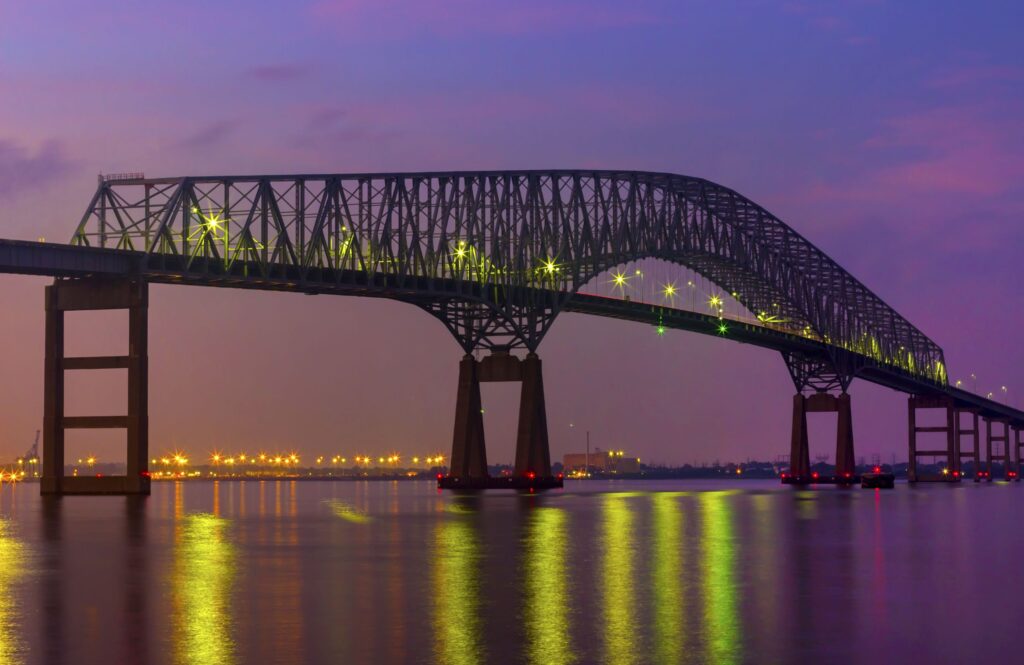
March 30, 2024
Dear Fellow Marylanders,
It’s hard to imagine Baltimore’s skyline without the Francis Scott Key Bridge, a visual symbol of connectivity and commerce, framing the backdrop of the city. Completed in 1977, five years after its construction began, the Key Bridge was an engineering marvel of its time. Spanning 1.6 miles, it stood as one of the longest continuous truss bridges in the United States. For nearly fifty years, it has been as iconic as its namesake.
The Key Bridge was a thoroughfare to the Port of Baltimore, one of the leading ports on the East Coast. It has been number one in the country for roll on/roll off shipping capacity, handling a record 1.3 million tons of roll on/roll off farm and construction machinery last year; carried 52.3 million tons of cargo, including 10.4 million vehicles; and created over 15,000 jobs each year. What the port and bridge itself means for Baltimore cannot be overstated. Before this week, losing such an economic powerhouse would have been unimaginable.
On Tuesday, we – Baltimoreans, Marylanders and billions of people across the globe – all witnessed the unimaginable become a reality. We watched together as a cargo ship lost power and crashed into the Key Bridge. The bridge collapsed in seconds. Witnessing a giant fall on screen is shocking, but the magnitude of the devastation became so much clearer when I joined the U.S. Coast Guard on a boat Wednesday to assess the damage up close. Seeing the gnarled, mangled metal jutting out of a freezing Patapsco River and the massive cargo ship tangled in steel put the depth of this catastrophe into perspective.
The human cost of a tragedy is always the most devastating. Myrna and I send our deepest condolences to the families of Alejandro Hernandez Fuentes, Dorlian Ronial Castillo Cabrera, Maynor Yassir Suazo Sandoval, Jose Mynor Lopez, Miguel Luna and the other missing worker, all of whom were lost during this horrible accident.
These men immigrated to our country in hopes of new opportunity. They were part of our Baltimore community and sadly, lost their lives helping to keep our country safe. Our prayers are with their friends and families, and our priority remains recovering the victims so their family can have closure. Because of quick action by the Bay pilot and first responders, more lives weren’t lost, but even one life lost is too many.
The human cost was great, and the economic cost also will be immense.
This unimaginable tragedy is going to affect our region and also the world. Every day the port is closed creates disruption to Baltimore, the U.S. economy and the global supply chain. The result could have a damaging, lasting impact.
In addition to closing the channel to port operations, the bridge’s destruction closes a key part of our beltway for North-South traffic on I-695, particularly for the 4,500 trucks that travel the bridge daily because they cannot not use the tunnels due to size or hazardous cargo.
There are few people who will not be affected by this tragedy, but none more immediately than the 8,000 dockworkers who make the Port of Baltimore one of the best in the nation. The direct impact on the port of Baltimore by payroll of those who work at the ports is about $2 million a day, but the impact reaches far beyond that. Small businesses in the region could lose money. Billions of dollars could be lost to the local economy.
The Maryland General Assembly is taking critical steps to help lift the financial burden for workers who may lose income, but make no mistake about it, our top priority is getting the shipping lane back open so these workers and the entire Port community can be back on the job.
Whenever there’s a catastrophic event affecting critical transportation infrastructure, our nation has always come together to cover the cost. President Joe Biden has made that commitment. I’ve talked to my colleagues on both sides of the aisle, and I believe that Congress will work together to make sure that the resources are there so that we can open our channel and get that bridge replaced as quickly as possible. Not just Baltimore, but the country depends on it.
The story of the Francis Scott Key Bridge doesn’t end here. Frankly, much of our country’s transportation infrastructure isn’t built for modern operations. Just in the last 70 years, cargo capacity has grown by nearly 3,000 percent. This setback presents a huge opportunity to rebuild the Key Bridge with the future in mind – with infrastructure that is safer and better equipped to handle the capacity of a 21st century economy.
Baltimore has faced many challenges, but through it all, we stick together. The courage, unity and leadership that first responders, community members and officials at every level of government have shown throughout this tragedy are what make us strong and resilient. As Governor Moore said, we’re “Maryland tough, Baltimore strong” and primed to make a comeback.
Thank you for your time. Please feel free to reply to this email with your thoughts on this or any other topic. I appreciate all the feedback we receive.
Sincerely,
Ben Cardin
